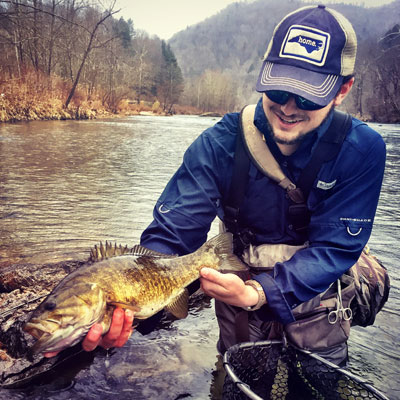
The early signs of Spring are already showing here in the Southern Appalachians. With the warming temperatures approaching, comes the droves of tourists who flock to our mountains to enjoy the vast amount of angling opportunities that are present here. With each passing year, however, it seems that the influx of combined local and tourist based angling pressure (along with several other environmental factors such as the drought this past summer) have led to a decline in wild trout populations as compared to years back. This has been a common concern among other guides all over Western North Carolina whom I’ve spoken to about the issue. Proper catch and release practices are needed, now more than ever, to help sustain healthy trout populations. One of the best tools in an angler’s arsenal, that can help keep their catch alive, is to use a landing net, which aids exponentially in a trout’s survival after being released.
The whole process of unhooking, photographing, and other unnecessary handling of a fish can last upwards of 30 seconds to 3 minutes. In that time, anglers inadvertently suffocate a fish and remove the delicate slime layer that protects it from bacterial infections underwater. Removing the slime layer can be caused by dry handling the fish with your hands along with prolonged exposure to wind/ freezing temperatures. A net also allows for the fish to not have to be squeezed to death when an angler is attempting to remove the hook from a trout (or any fish). Holding a trout too firmly can cause internal bleeding and irreversible organ damage from which the fish cannot survive. Unhooking and photographing a fish can all be accomplished while the fish is fully submerged underwater, which allows the fish to recover from lactic acid build up in it’s body. Lactic acid buildup, caused from fighting or mishandling fish too long, can result in the fish swimming off after being released only to die because it can’t remove the toxins from its system.
I carry two types of nets with me wherever I fish: a long- handled net with a wide opening, and a short net. A longer guide net is great for situations where you know there is a chance for hooking into larger fish, while I save my shorter net for situations such as a small wild trout stream with smaller average fish lengths. Both of my nets are deep so that I can fully submerge a fish into the water and are made out of soft knotless webbing with a flat bottom to the net.
It’s possible to write a whole book on proper catch and release practices that are applicable for today’s angler, and I know I haven’t even begun to scratch the surface in this article, but I hope it can serve as a good starting point. We, as anglers, are responsible for taking care of and being active in the process of conserving our wild fish populations here in Western North Carolina (and everywhere, for that matter). Educating yourself and others, and carrying a net may seem mundane and simple, but have a more lasting affect than most people realize.
Ethan Hollifield is a native North Carolinian from Spruce Pine. While earning a degree in Parks and Natural Resource Management from NC State, he was a member of the three-time national championship-winning bass fishing team “BassPack”. Ethan currently guides for Stonefly Outfitters in Burnsville, North Carolina.